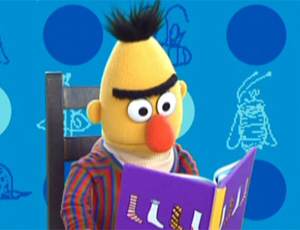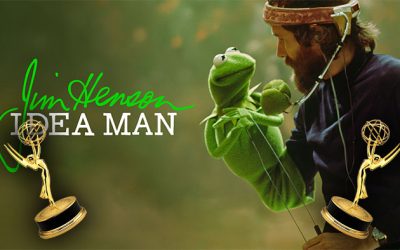 Irony Sesame
Irony Sesame
Friday, April 19
Anyway, back to the show. In today’s episode, Ernie wants to play Ernie Says, but Bert is busy reading a book. “Hey, we can play Ernie Says with a book,” Ernie says. “Ernie Says: Get a book! Uh… scuse me, Bert, would you mind if I borrowed that book?” He grabs Bert’s book, and starts the game. “Ernie Says: Put the book in front of your face!” Bert wants his book back. “Now, Ernie Says: Make your book walk!” He moves the open book back and forth like it’s walking. “Now, Ernie Says: Make your book talk! Like this! Hi, there — I’m a talking book!” Then it’s on to dancing with your book, wearing your book like a hat, and taking your book for a drive around the room. Bert objects, saying that he wants to read his book. Ernie thinks that’s a good idea, and announces: “Ernie Says, read your book!” He sits down and reads Bert’s book. Bert sighs and walks off.
Then there’s a pause of exactly two seconds before they start showing us film clips of kids making animal sounds.
Now, call me old-fashioned, but is that really the way to encourage kids to read? It’s fun to wear your book like a hat, it’s fun to dance with your book — but when we tell you to sit down and read your book, we instantly distract you with mooing children. It’s kind of a mixed message.
When you think about it, there’s something fishy about the whole concept of an “interactive TV show.” The whole point of television — and this isn’t me being crabby media-crit boy, this is the real actual purpose of everything on television — is for you to keep watching television. So no matter how much Play With Me Sesame talks about reading or drawing pictures or playing on the computer, the thing they really want you to do is to keep watching Play With Me Sesame. If Noggin did audience research that found that after watching Play With Me Sesame, kids went off and spent more time playing imagination games with household objects and less time watching Noggin, they’d take it off the air so fast your little blue head would spin.
This is the weird contradiction of educational TV, really. Any reasonable goal of education — to inspire kids on a personal level, to encourage them to ask questions and actively engage with the world — that’s completely different from the goal of television, which is to keep big groups of them watching long enough to sell them cheese doodles.
So Play With Me Sesame, I think, is pretty much the endpoint of the whole educational TV fad. This is the end of the line, as far as we can go before the whole concept of educating kids en masse through a TV screen just falls to pieces.
The only logical next step, which I’m expecting will debut in 2005, is No TV Sesame, where you turn on the TV and find Oscar, glowering at you and telling you to go play outside.
That’ll be followed in 2010 by the Raise Me Sesame parenting appliance, a fully programmed cyberparent that’ll engage your kids in loving, age-appropriate play, from infancy until they graduate from law school. Elmo will come as the standard default setting, but you can purchase other Muppets separately as plug-in content modules — a Grover Self-Esteem module that teaches your kids how to tie their shoes, a Cookie Monster Healthy Eating module that encourages them to clean their plates.
That’ll be the state of the art until 2020, when you’ll be able to purchase your own farm-raised kid from Reproduce Me Sesame. For just a small deposit upfront, you’ll receive a smart, healthy three year old, able to care for a goldfish, count up to 40, and organize an international human rights conference.
Don’t be fooled by the cheap Taiwanese knockoff children! Make sure you look for the official Sesame Workshop brand on each child before you bond with them.
by Danny Horn

 Irony Sesame
Irony Sesame

